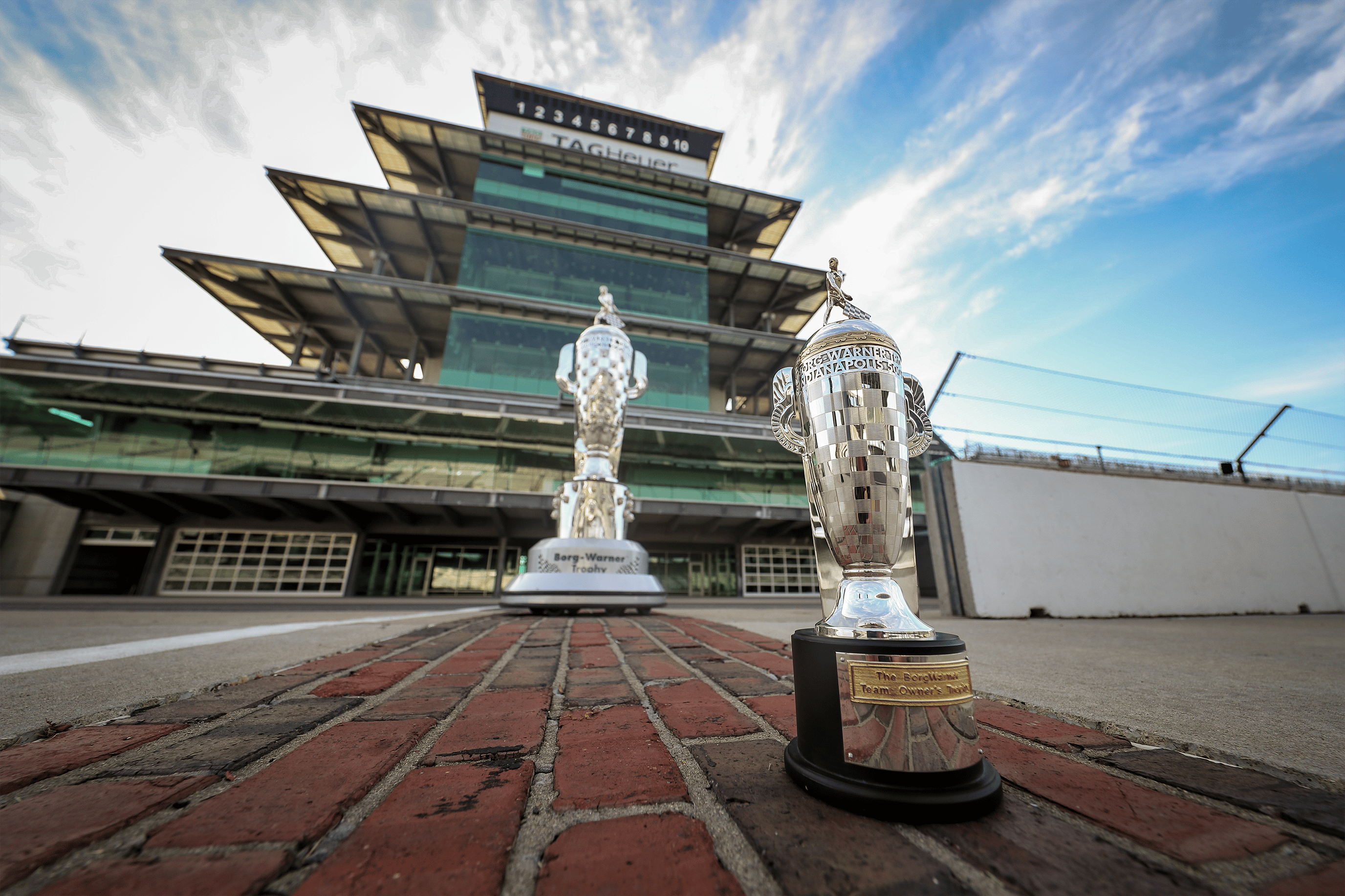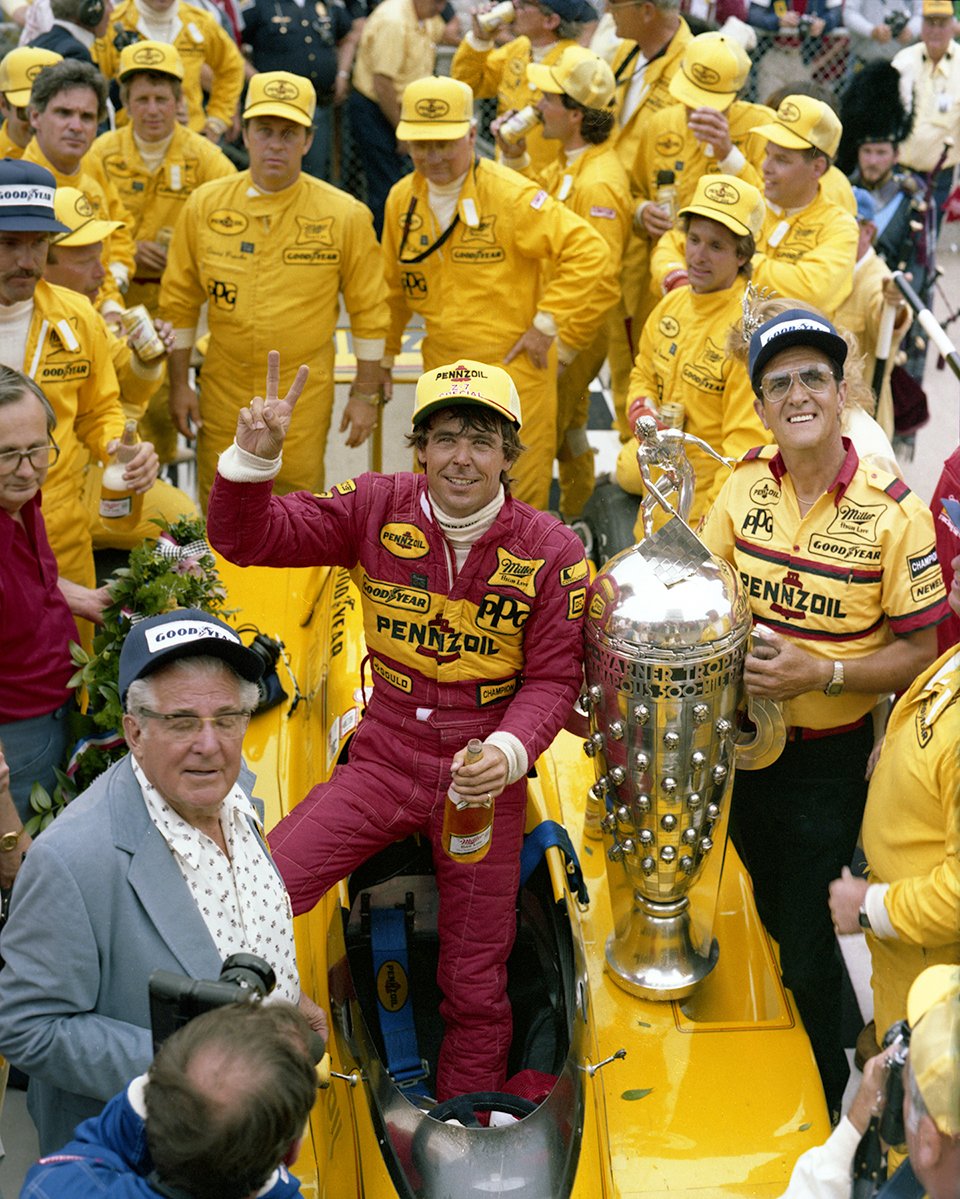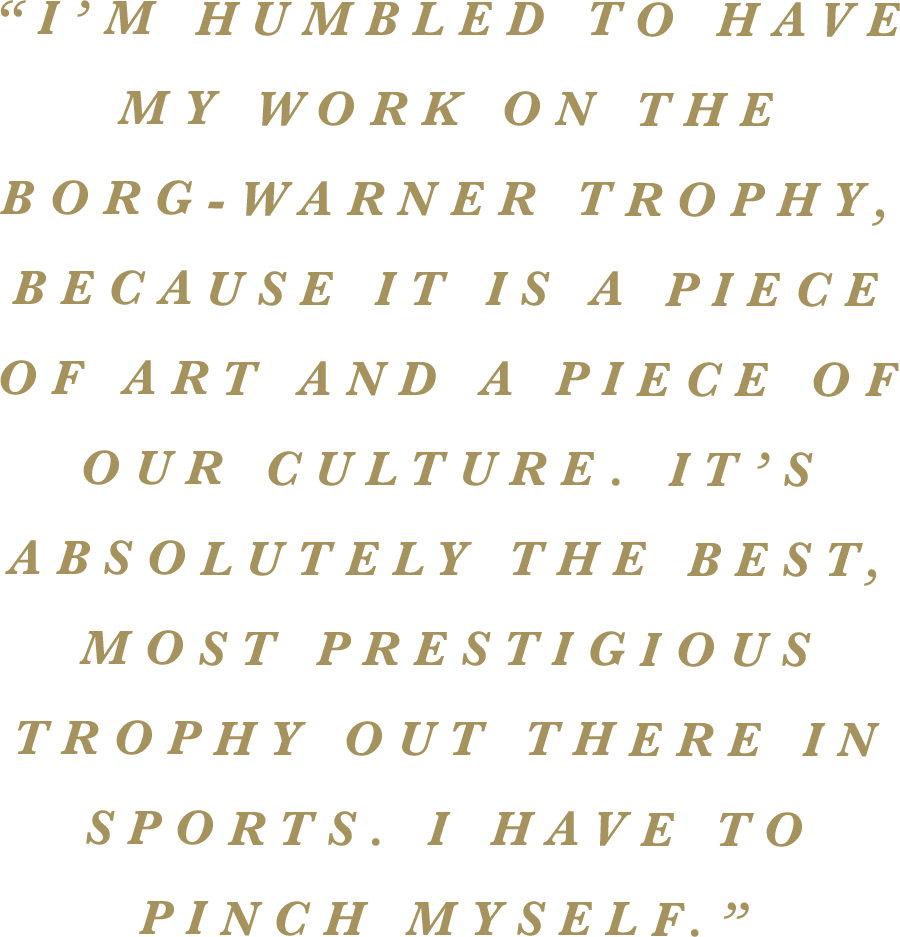

No, the winner of the Indianapolis 500 does not get to keep the Borg-Warner Trophy, not even for a minute. It is permanently housed and displayed at the Indianapolis Motor Speedway Museum.
They do, however, get a miniature version of the trophy. Officially called the BorgWarner Championship Driver’s Trophy, it is affectionately referred to as the “Baby Borg.” And if it weren’t for four-time Indy 500 winner Rick Mears, this trophy might not exist.
Starting in 1936, the winner of the race received a wooden plaque with a small, half replica of the Borg-Warner Trophy affixed on it as their take-home prize.
After the 1988 Public Drivers’ Meeting, Mears inquired with BorgWarner representatives about how much it would cost to get two more halves of the replica trophy, because he wanted to build miniature versions of the trophy on a base. Oh, and he also wanted a copy of his face that is featured on the Borg-Warner Trophy that he could put on that base.
The next day, Mears won his third “500,” and he assumed his inquiry got lost in the hype that surrounds the race. However, he got a call a month later from BorgWarner telling him that they were creating a new trophy, called a “Baby Borg.” The kicker? It was exactly what Mears had described.
In January 1989, Mears received a 14-inch version of the Borg-Warner Trophy with his likeness sculpted on the black marble base, and so has every winning driver since.

“BABY BORG”

In 1998, BorgWarner established the BorgWarner Championship Team Owner’s Trophy so owners can have a keepsake from the monumental win, as well. This trophy is different, though, as it features a band of Art Deco race cars accented in gold to symbolize the importance of teamwork.


“I don’t know how much I had to do with it other than we just had the conversation, but it was great. It did surprise me. They basically did what I was wanting to do with mine. It did cross my mind, but I just thought it was cool, whether it was because I said anything or not. It’s a classy trophy.”
– RICK MEARS




In 1935, Borg-Warner Corporation commissioned designer Robert J. Hill and Spaulding-Gorham Inc. to create a commemorative trophy honoring the winner of the Indianapolis 500. In early 1936, then-Speedway owner Eddie Rickenbacker unveiled the trophy at a dinner, declaring it the annual prize for Indianapolis 500 winners.
While the trophy was new when it arrived that May, it also went back in time. Sculpted on the trophy’s cup were the 24 faces of every race winner from 1911 through 1935 with their name, year and average speed engraved below their quarter-sized faces.
The trophy in its original form was 52 inches tall, 80 pounds of sterling silver and cost $10,000. Over time, the trophy has grown. Originally crafted to commemorate 70 race winners (the last being Bobby Rahal in 1986), two bases have been added to the trophy in 1987, and 2004. The trophy is now valued at $3.5 milion, and the current base can accommodate each Indy 500 winner through 2033.
It is pure coincidence that Louis Meyer, one of the most influential people in Indy 500 history because of his love for buttermilk, which spawned the tradition of the winner drinking milk, was the first recipient of the trophy. However, the trophy didn’t appear in Victory Lane until 1939, when another iconic name won the “500” – Wilbur Shaw.


– Louis Meyer



– Simon Pagenaud

The Borg-
Warner Trophy
is so recognizable because it is one of the most constant pieces of the Indianapolis 500 aside from the racetrack itself. Celebrating its 85th anniversary in 2021, the Borg-Warner Trophy has lived through three different Speedway ownership groups, one World War and 82 500-Mile races.
There’s nothing else like it. The name, year and average speed of each winner is engraved on the trophy, but what sets this work of art apart from the rest is the faces.
The Borg-Warner Trophy is one of the most recognizable prizes in all of sports. It’s art, speed and elegance all wrapped in one, chronicling every moment of the Indianapolis 500 it has witnessed.

BORG-WARNER – 85 YEARS


The sculpting of the face happens over a period of months, and world-renowned sculptor Will Behrends is the face behind the faces.
Behrends got his first opportunity to create a face for the Borg-Warner Trophy in 1990, when BorgWarner commissioned a different prominent American sculptor each year. BorgWarner and the Speedway were so captivated by how Behrends captured 1990 winner Arie Luyendyk’s luscious locks of hair that they have continued to commission him ever since.

SCULPTING
GREATNESS

BorgWarner Inc.


“I’m humbled to have my work on the Borg-Warner Trophy, because it is a piece of art and a piece of our culture. It’s absolutely the best, most prestigious trophy out there in sports. I have to pinch myself.”
– Will Behrends

Behrends’ work begins shortly after the race is over when the winning driver sits for a photoshoot that gives provides a 360-degree view of their head. He then takes those photographs and creates a life-sized version of their head, as he describes in the video below about the process following the 100th Running of the Indy 500 in 2016
After nailing down the details on the life-sized version, he replicates it on a smaller scale – smaller than an egg – to fit on the trophy. It’s not done mechanically or digitally. Simply by memory and two hands.
Back in 1990, Behrends mixed his own clay to build Luyendyk’s face – enough for just one face (in his defense, he thought this was a one-year gig). As Behrends has been brought back for 30 years now, he has used the exact same clay every year.
Behrends said the clay model of the winner sits on his shelf for a year until a new winner is crowned, and only then does he morph the previous winner’s face into the next winner’s likeness.
• At 74,538-square feet and 303 feet tall by 246 feet wide, the world largest Borg-Warner Trophy was featured on the JW Marriott in downtown Indianapolis, welcoming race fans for the 100th Running in 2016.
• There is one gold face on the Borg-Warner Trophy: Former Speedway owner Tony Hulman, whose face was the first one to be featured on the base in 1987.
• There are two sets of two drivers’ faces for one year on the trophy, as they co-drove to victory: L.L. Corum / Joe Boyer in 1924 and Floyd Davis / Mauri Rose in 1941.
• Four-time winner A.J. Foyt has just two different faces on the trophy. The same likeness was used for his wins in 1961, ’64 and ’67, while a second likeness was used in 1977.
• Al Unser’s 1970 likeness is the last to feature an open-face helmet.
• 1983 winner Tom Sneva is the only driver on the trophy wearing glasses, at his request.
• There are 13 countries and 21 U.S. states represented on the trophy.
FUN FACTS




BorgWarner Inc.
BorgWarner Inc.


WHERE TRADITION NEVER STOPS

BORG-WARNER–85 YEARS



It’s one of the most recognizable trophies in all of sports. It’s art, speed and elegance all wrapped in one that has chronicled every moment of the Indianapolis 500 that it has witnessed.

– Simon Pagenaud

“The trophy and BorgWarner have a big impact on this event. It’s amazing to think this likeness will live forever. No other trophy gives you that except the Borg-Warner Trophy.”

The Borg-
Warner Trophy

is so recognizable because it is one of the most constant pieces of the Indianapolis 500 aside from the racetrack itself. Celebrating its 85th anniversary in 2021, the Borg-Warner Trophy has lived through three different Speedway ownership groups, one World War and 82 500-Mile races.
There’s nothing else like it. The name, year and speed of each winner is engraved on the trophy, but what sets this work of art apart from the rest is the faces. These faces don’t just honor the newly crowned winner, their position on the trophy cements their place in history alongside every winner of this legendary sporting event.



In 1935, Borg-Warner Corporation commissioned designer Robert J. Hill and Spaulding-Gorham Inc. to create a commemorative trophy honoring the winner of the Indianapolis 500. In early 1936, then-Speedway owner Eddie Rickenbacker unveiled the trophy at a dinner, declaring it the annual prize for Indianapolis 500 winners.
While the trophy was new when it arrived that May, it also went back in time. Sculpted on the trophy’s cup were the 24 faces of every race winner from 1911 through 1935 with their name, year and average speed engraved below their quarter-sized faces.

ORIGINS

The trophy in its original form was 52 inches tall, 80 pounds of sterling silver and cost $10,000. Over time, the trophy has grown. Originally crafted to commemorate 70 race winners (the last being Bobby Rahal in 1986), two bases have been added to the trophy in 1987, and 2004. Now valued at $3.5 million, the current base can accommodate each Indy 500 winner through 2033.
It is pure coincidence that Louis Meyer, one of the most influential people in Indy 500 history because of his love for buttermilk, was the first recipient of the trophy. However, the trophy didn’t appear in Victory Lane until 1939, when another iconic name won the “500”
– Wilbur Shaw.



• The trophy in its original form was 52 inches tall, 80 pounds of sterling silver and cost $10,000.
• There is one gold face on the Borg-Warner Trophy: Former Speedway owner Tony Hulman, whose face was the first one to be featured on the base in 1987.
• There are two sets of two drivers’ faces for one year on the trophy: L.L. Corum / Joe Boyer in 1924 and Floyd Davis / Mauri Rose in 1941.
• Four-time winner A.J. Foyt has just two different faces on the trophy. The same likeness was used for his wins in 1961, ’64 and ’67, while a second likeness was used in 1977.
• Al Unser’s 1970 likeness is the last to feature an open-face helmet.
• 1983 winner Tom Sneva is the only driver on the trophy wearing glasses, at his request.
• There are 13 countries and 21 U.S. states represented on the trophy.
FUN FACTS

– Louis Meyer

“Winning the Borg-Warner Trophy is like winning an Olympic medal.”




Behrends’ work begins shortly after the race is over when the winning driver sits for a photo shoot that provides a 360-degree view of their head. He then takes those photographs and creates a life-sized version of their head in his studio in the hills of western North Carolina.
After nailing down the details on the life-sized version, Behrends replicates it on a smaller scale – smaller than an egg – to fit on the trophy. It’s not done mechanically or digitally. Simply by memory and two hands.
Back in 1990, Behrends mixed his own clay to build Luyendyk’s face – enough for just one face (in his defense, he thought this was a one-year gig). As Behrends has been brought back for 30 years now, he has used the exact same clay every year.
Behrends said that the clay model of the winner sits on his self for a year until a new winner is crowned, and only then does he morph the previous winner’s face into the next winner’s likeness.
– Will Behrends

“I’m humbled to have my work on the Borg-Warner Trophy, because it is a piece of art and a piece of our culture. It’s absolutely the best, most prestigious trophy out there in sports. I have to pinch myself.”

The sculpting of the face happens over a period of months, and world-renowned sculptor Will Behrends is the face behind the faces.
Behrends got his first opportunity to create a face for the Borg-Warner Trophy in 1990 when BorgWarner commissioned a different prominent American sculptor each year. BorgWarner and the Speedway were so captivated by how Behrends captured 1990 winner Arie Luyendyk’s luscious lochs of hair that they have continued to commission him ever since.



In 1998, BorgWarner established the BorgWarner Championship Team Owner’s Trophy so that owners can have a keepsake from the monumental win as well. This trophy is different, though, as it features a band of art deco race cars accented in gold to symbolize the importance of teamwork.

– RICK MEARS

“I don’t know how much I had to do with it other than we just had the conversation, but it was great. It did surprise me. They basically did what I was wanting to do with mine. It did cross my mind, but I just thought it was cool, whether it was because I said anything or not. It’s a classy trophy.”


No, the winner of the Indianapolis 500 does not get to keep the Borg-Warner Trophy, not even for a minute. It is permanently housed and displayed at the Indianapolis Motor Speedway Museum.
They do, however, get a miniature version of the trophy. Officially called the BorgWarner Championship Driver’s Trophy, it is affectionately referred to as the “Baby Borg.” And if it weren’t for four-time Indy 500 winner Rick Mears, this trophy might not exist.
Starting in 1936, the winner of the race received a wooden plaque with a small, half replica of the Borg-Warner Trophy affixed on it as their take-home prize.
After the 1988 public drivers’ meeting, Mears inquired with BorgWarner representatives about how much it would cost to get two more halves of the replica trophy, because he wanted to build miniature versions of the trophy on a base. Oh, and he also wanted a copy of his face that is featured on the Borg-Warner Trophy that he could put on that base.
The next day, Mears won his third “500,” and he assumed his inquiry got lost in the hype that surrounds the race. However, he got a call a month later from BorgWarner telling him that they were creating a new trophy, called a “Baby Borg.” The kicker? It was exactly what Mears had described.
In January 1989, Mears received a 14-inch version of the Borg-Warner Trophy with his likeness sculpted on the black marble base, and so has every winning driver since.

“BABY BORG”




The Borg-
Warner Trophy
WHERE TRADITION NEVER STOPS

